Futures prop trading firms offer traders the ability to trade with firm-provided capital, sharing profits based on performance. This article lists 20 firms, highlighting their key features like evaluation costs, payout speeds, profit splits, and unique advantages. Here’s a quick summary:
- Topstep (2012): A veteran in CME futures trading with a two-tier profit split and strong educational resources.
- FundingTicks (2025): UAE-based, offers fast payouts (as little as 5 days) and low-cost evaluations.
- Tradeify (2024): US-based, known for instant funding and tech-friendly platforms.
- My Funded Futures (2023): Transparent 80/20 profit split and simple rules.
- Lucid Trading (2025): Fast payouts in 15 minutes and user-friendly processes.
- Apex Trader Funding (2021): Flexible programs, strong community, and weekly payouts.
- TickTick Trader (2022): 100% profit split with flexible, on-demand payouts.
- Take Profit Trader (2021): Steady scaling with a straightforward approach.
- TradeDay (2020): Focuses on trader education and coaching.
- Bulenox (2021): Affordable evaluations with solid payout timelines.
- BluSky Trading (2022): Low-cost entry and competitive profit splits.
- Phidias Propfirm (2024): Modular programs with transparent tracking.
- Purdia Capital (2024): Daily payout requests processed in 24 hours.
- Legends Trading (2024): Milestone-based scaling and weekly payouts.
- Day Traders (2025): New firm with fast scaling options.
- The Futures Desk (UK & US) (2024): Regional support with clear rules.
- FundedNext Futures (2025): Rapid payouts and global presence.
Quick Comparison Table
| Firm Name | Year Established | Headquarters | Key Feature(s) |
|---|---|---|---|
| Topstep | 2012 | US | CME focus, 100% profit on first $10k earned |
| FundingTicks | 2025 | UAE | Payouts in 5 days, low-cost evaluations |
| Tradeify | 2024 | US | Instant funding, tech-friendly platform |
| My Funded Futures | 2023 | US | 80/20 profit split, simple rules |
| Lucid Trading | 2025 | US | Payouts in 15 minutes, no delays |
| Apex Trader Funding | 2021 | US | Flexible programs, weekly payouts |
| TickTick Trader | 2022 | Isle of Man | 100% profit split, on-demand payouts |
| Take Profit Trader | 2021 | US | Gradual scaling, clear rules |
| TradeDay | 2020 | US | Education-focused, strong coaching support |
| Bulenox | 2021 | US | Affordable evaluations, predictable payouts |
| BluSky Trading | 2022 | US | Low-cost entry, competitive profit splits |
| Phidias Propfirm | 2024 | Gibraltar | Modular programs, transparent tracking |
| Purdia Capital | 2024 | US | Payouts processed in 24 hours |
| Legends Trading | 2024 | US | Milestone scaling, weekly payouts |
| Day Traders | 2025 | US | Fast scaling, modern dashboard |
| The Futures Desk (UK) | 2024 | UK | EU/UK support, clear guidelines |
| The Futures Desk (US) | 2024 | US | US-focused, simple evaluation process |
| FundedNext Futures | 2025 | UAE | Rapid payouts, strong global presence |
Choose a firm that aligns with your trading goals, risk tolerance, and payout preferences. Each firm offers distinct features, so consider evaluation costs, payout speed, and profit splits carefully.
Ultimate Futures Prop Firm Tier List 2025 (From A 7 Figure Trader)
1. FundingTicks

Established in 2025 and headquartered in the United Arab Emirates, FundingTicks provides a streamlined way for traders to transition from evaluation to funded trading. It’s designed for those looking for quick and hassle-free access to trading capital. Here’s a breakdown of their offerings and how they cater to traders’ needs.
Evaluation Cost
FundingTicks offers various account models, including the Pro+ Model, Zero Master, and FundingTicks One. These options are tailored to fit different trading styles and budgets, helping traders minimize upfront costs while aligning with their trading preferences.
Payout Speed
One of the standout features of FundingTicks is its fast reward cycles, which vary by account type:
| Account Type | Reward Cycle | Withdrawal Condition |
|---|---|---|
| Live Master (Pro+) | 5 Days | 5 profitable days (minimum $100 daily profit) |
| Zero Master | 7 Days | 5 profitable days (minimum $100–$200 daily profit) |
| FundingTicks One | Every 7 Days | Minimum payout of 1% ($250 for 25k, $500 for 50k) |
The company highlights its speed with the statement:
"Fastest Rewards Get paid in as little as 5 days."
For traders using the Pro+ Model, payouts are available just five trading days after the funded account becomes active. Once traders complete their evaluation and achieve five profitable days, they can request their first payout.
Ease of Scaling
FundingTicks ensures dependable payouts with a straightforward approach:
"Quick and reliable. Zero reward denials."
This reliability allows traders to grow their accounts confidently, knowing their performance directly translates into earnings.
2. FundedNext Futures
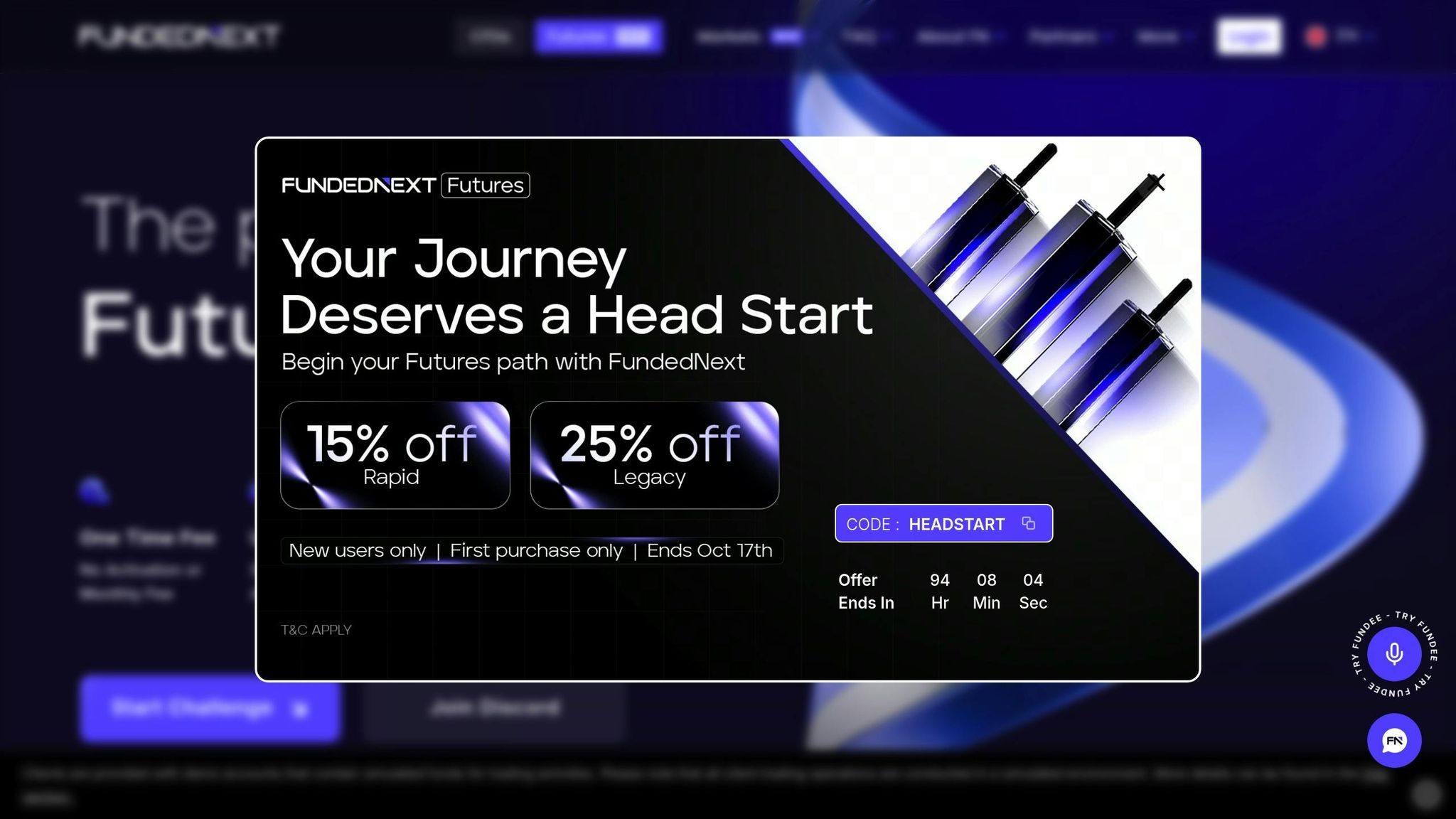
FundedNext Futures focuses on speed and efficiency in the world of prop trading. The platform ensures quick access to funds and rapid payouts. Once traders meet the required conditions and submit withdrawal requests, funds are processed within just 24 hours. For traders in the Rapid Challenge, Performance Rewards can be claimed as soon as three days after fulfilling the Consistency Rule.
Withdrawal methods include popular options like USDT (ERC20, TRC20), USDC (ERC20), and RiseWorks.
3. Tradeify
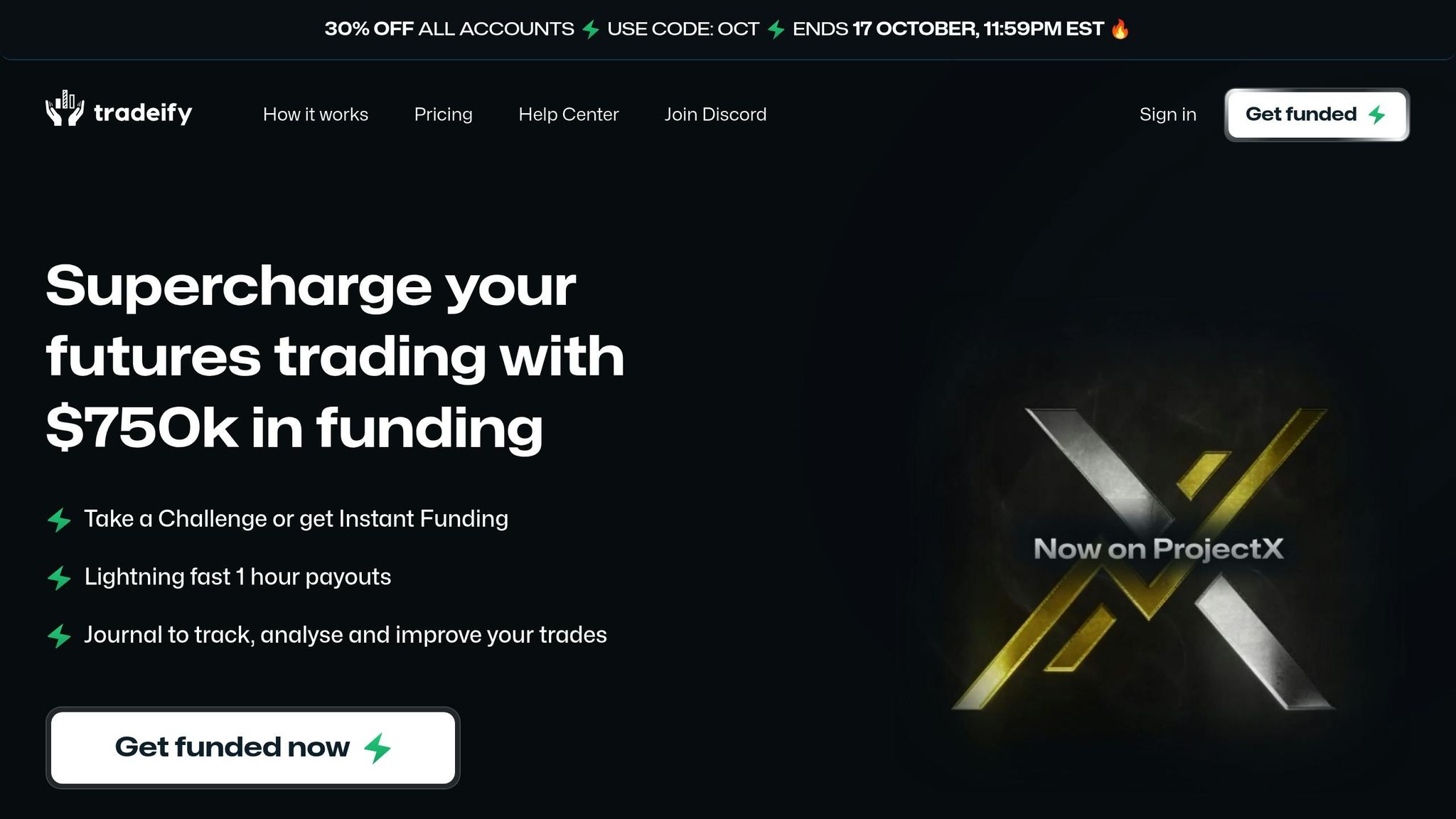
Building on the momentum of FundedNext Futures, Tradeify stands out as another strong contender in the futures trading space. Established in 2024 in the United States, this firm has carved a niche by offering instant funding and a platform that’s easy to integrate. These features make it especially appealing to traders who prioritize speed and a tech-forward trading experience. With its focus on efficiency and innovation, Tradeify has quickly become a popular choice among futures prop trading firms, making it a noteworthy option for comparison.
4. My Funded Futures

Founded in 2023 in the United States, My Funded Futures stands out with its clear rules and reliable services. The company has quickly earned a reputation for its focus on transparency and consistency, making it easier for traders to understand their potential earnings from the start.
Profit Split
My Funded Futures keeps things simple with an 80/20 profit split across all its plans – Core, Scale, and Pro. Traders retain 80% of their profits, no matter the funding stage. This straightforward approach aligns with the company’s transparent evaluation process, helping traders feel confident about their earning potential right from the beginning.
5. Take Profit Trader
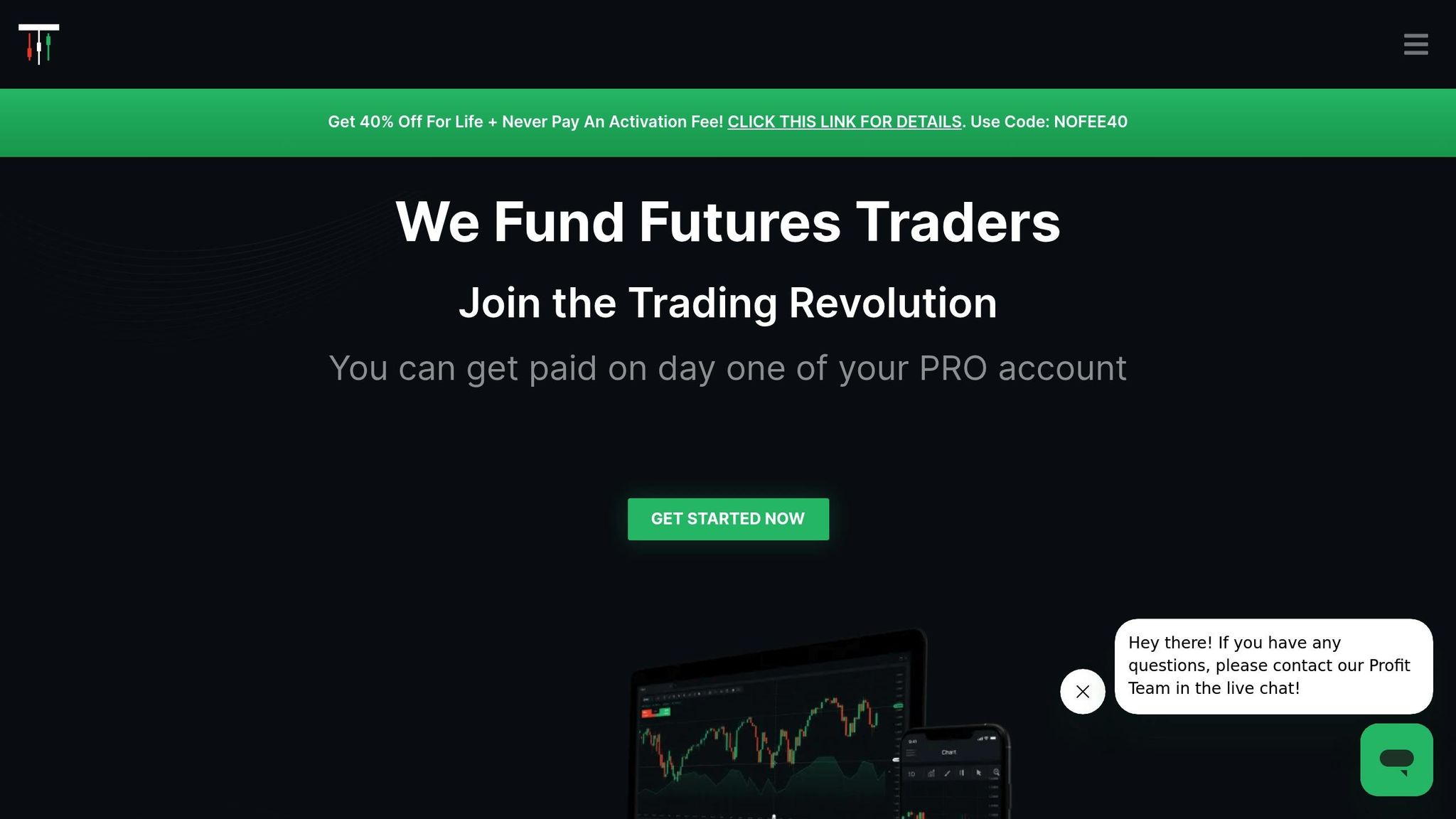
Established in 2021 in the United States, Take Profit Trader provides a simple, no-frills approach to account growth. Their straightforward scaling system allows traders to steadily expand their accounts without unnecessary hurdles. This clear-cut method positions Take Profit Trader as a dependable mid-tier choice, complementing the diverse strategies offered by other U.S.-based firms.
6. Topstep
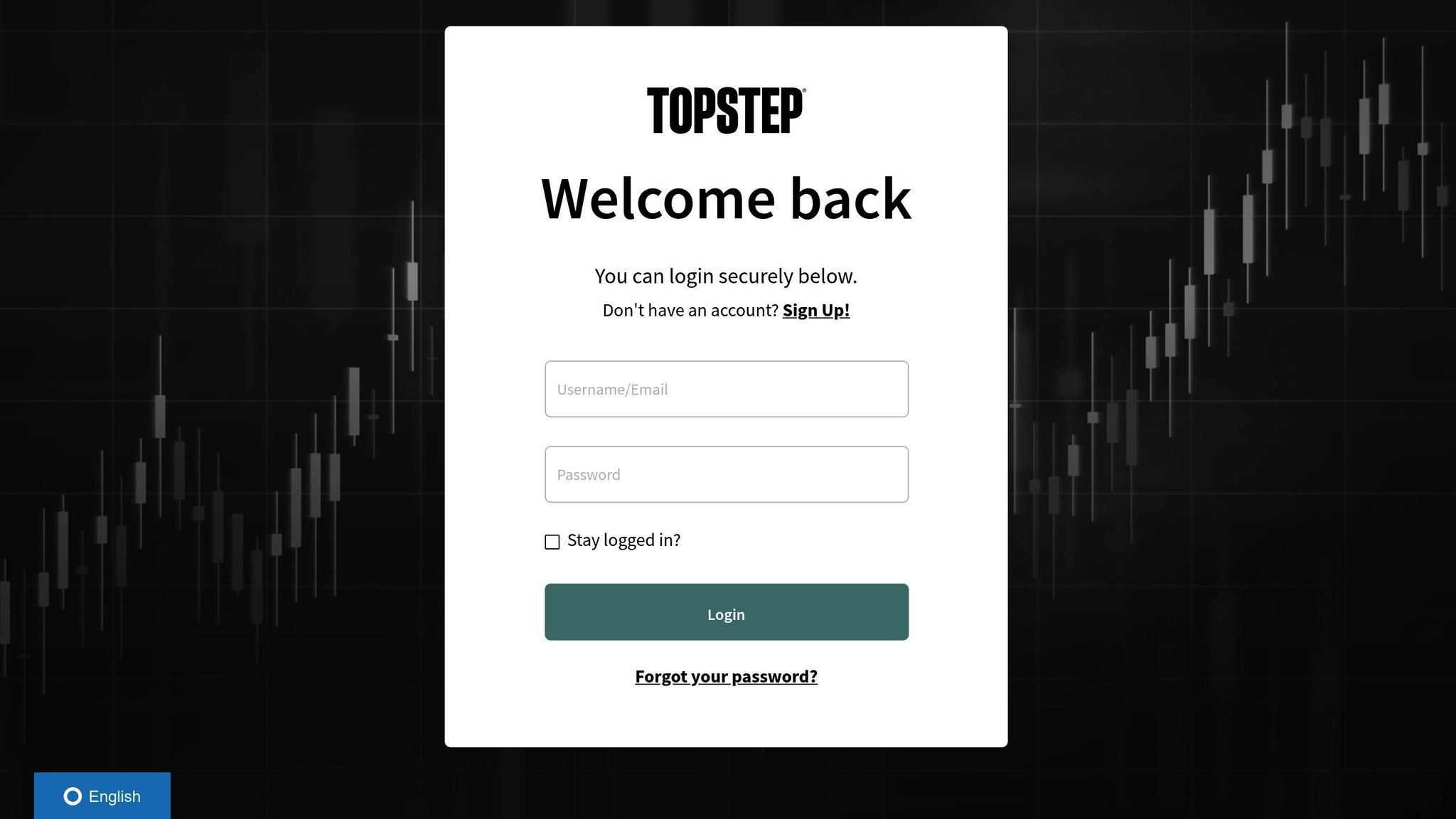
Topstep, established in 2012, is all about CME futures trading. It focuses on instruments like the E-mini S&P 500, crude oil, natural gas, gold, and treasury bonds. Beyond trading, it emphasizes education to help traders develop long-term, sustainable skills.
With over a decade of experience in futures prop trading, Topstep has built a reputation for combining practical trading opportunities with skill-building programs.
Evaluation Costs
Topstep’s evaluation process is designed specifically for CME futures trading. At the heart of this is the Trading Combine program, which assesses traders before they can access funded accounts. Account sizes range from $50,000 to $150,000, ensuring the process aligns with the unique demands of CME futures trading.
Profit Split
Topstep uses a two-tier profit-sharing structure that benefits traders right from the start. Here’s how it works: traders keep 100% of the first $10,000 they earn. After that, they receive 90% of any additional profits. This setup not only rewards early success but also motivates traders to achieve consistent profitability.
Payout Speed
Payouts are processed after thorough verification, ensuring proper risk management. While this might mean some variation in timing, it reflects Topstep’s commitment to maintaining a secure trading environment.
Ease of Scaling
Topstep takes a careful approach to scaling trader accounts, capping the maximum account size at $150,000. This deliberate strategy ensures strong risk management practices and supports steady, sustainable growth for traders.
7. Lucid Trading

Lucid Trading, based in the US and established in 2025, has made a name for itself by offering fast and straightforward payouts for funded futures traders. The company’s focus on efficiency and simplicity has earned it a reputation for seamless payout processes.
Payout Speed
Lucid Trading prides itself on delivering payouts and activations in record time, with an average processing time of just 15 minutes. Their flexible withdrawal system ensures traders can access their earnings whenever they need, emphasizing the convenience of their Instant Payouts feature.
8. TradeDay

Launched in 2020 in the U.S., TradeDay stands out for its strong emphasis on education. With comprehensive coaching and clear resources for trader development, it caters to both beginners and seasoned futures traders. This dedication to learning underscores TradeDay’s mission to help traders succeed at every stage of their journey.
9. Apex Trader Funding

Apex Trader Funding, established in 2021, has quickly gained traction among futures traders by creating a strong sense of community and offering a variety of account options. With promotional discounts and a focus on fostering connections within its trading network, it has become an attractive option for those looking to access funded trading opportunities.
10. The Futures Desk (UK)
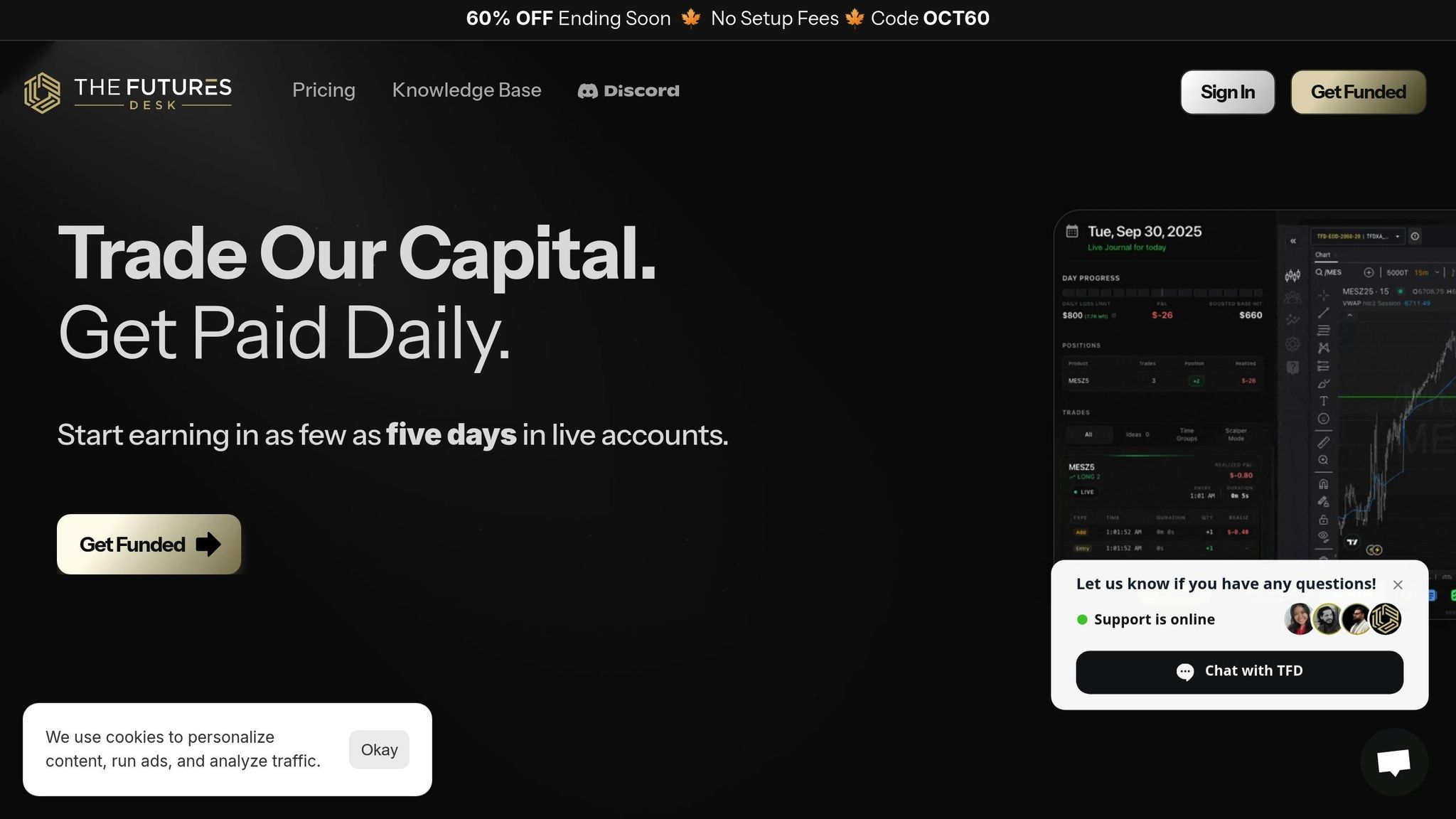
The Futures Desk (UK) caters specifically to traders in the UK and the EU. Established in 2024, this firm has quickly gained attention for its strong regional focus. With clear guidelines and professional support, it ensures traders receive consistent assistance during both the evaluation and live trading stages.
11. The Futures Desk (US)
The Futures Desk (US), introduced in 2024, simplifies the evaluation process with a single-step system and domestic routing. Their pricing is straightforward, making it easy to understand.
Evaluation Cost
They offer three challenge plans, all with no activation fee:
- Starter Challenge: $139
- Popular Challenge: $299
- Premium Challenge: $449
Currently, they’re running a promotion where you can get 60% off by using the code OCT60.
12. TickTick Trader

TickTick Trader, founded in 2022 on the Isle of Man, stands out among futures prop firms with its straightforward evaluation process and flexible pricing options. Designed to cater to various trading styles and capital needs, the firm offers multiple account types and clear payout benefits.
Evaluation Cost
TickTick Trader provides three main account options with different pricing structures to fit traders’ preferences:
- Evaluation Accounts: These accounts operate on a monthly fee basis. The starting costs are $87 for a $25,000 account, $96 for a $50,000 account, and range from $171 to $198 for a $100,000 account.
- Direct Accounts: For traders who want immediate access to funding, these accounts come with one-time fees. Pricing starts at $229 for $10,000, $349 for $25,000, and $699 for $50,000 in funding.
- Bundle Accounts: Ideal for aggressive scalpers, these accounts offer three funding accounts for one payment. Options include $75,000 total funding for $239, $150,000 for $269, or $300,000 for $479. However, bundle plans require an additional $149 activation fee per validated account.
While the minimum challenge price of $87 is on the higher side, it reflects a focus on attracting serious and committed traders.
Profit Split
TickTick Trader offers traders a 100% profit split, allowing them to keep all their earnings after fulfilling the firm’s requirements. This straightforward approach eliminates the need for negotiations and aligns with other top-tier firms in the industry.
Payout Speed
Withdrawals are highly flexible, as traders can request payouts at any time. This on-demand system is particularly attractive for active traders who need quick access to their profits.
Ease of Scaling
Scaling is made simple with TickTick Trader’s bundle system, enabling traders to manage up to $300,000 across multiple accounts. The firm supports 30+ trading instruments and integrates with platforms like NinjaTrader, Bookmap, and Daytradr, providing ample opportunities for traders to diversify their strategies.
Risk management rules include a 3.5% maximum daily drawdown, a 10% maximum drawdown, and a 6% first profit target. While these parameters are tighter than some competitors, they remain achievable for disciplined and focused traders.
13. Bulenox
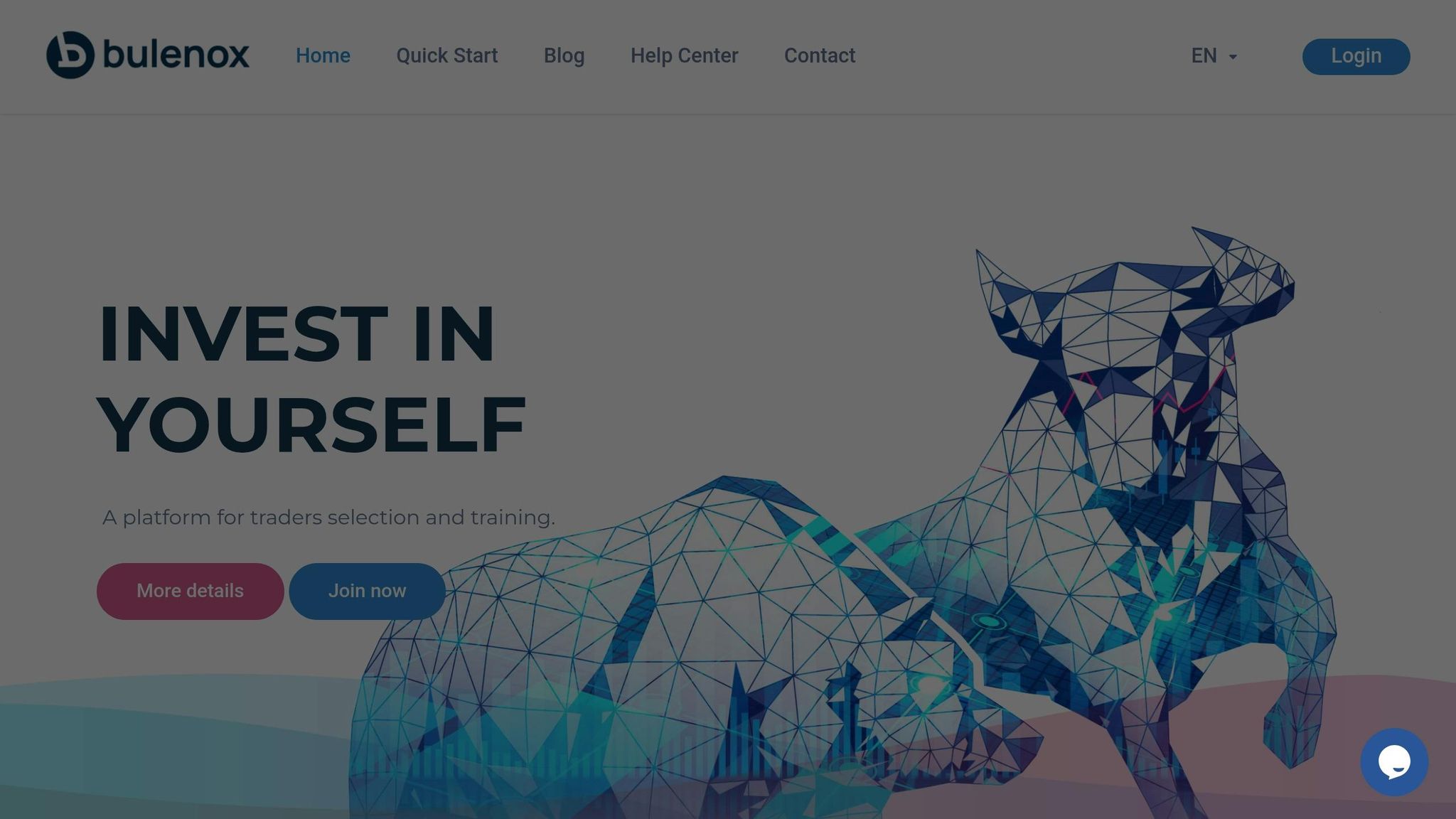
Bulenox, founded in 2021, has quickly gained attention in the futures prop trading world by offering an affordable and straightforward approach. With a focus on reliability and transparency, the firm provides traders with accessible funding opportunities and a simple evaluation process.
Evaluation Cost
If you’re looking for a budget-friendly option, Bulenox might be the right fit. While the company doesn’t openly share detailed pricing tiers, its reputation suggests it caters to traders seeking lower-cost evaluations. Most evaluation programs in the industry range from $49 to $300 per month, and Bulenox appears to operate on the more affordable end of that spectrum.
Profit Split
Though Bulenox hasn’t disclosed its exact profit split percentages, it aligns with industry norms for mid-tier futures prop firms, which typically offer traders between 80% and 90% of profits. Based on their focus on simplicity and value, traders can likely expect a profit split in the 80–85% range. Their payout structure avoids unnecessary complexity, making it easier for traders to understand and access their earnings.
Payout Speed
Bulenox seems to prioritize transparency when it comes to withdrawals. With straightforward payout milestones, traders can anticipate receiving their funds within 3–7 business days – right in line with industry standards. This predictable timeline ensures steady cash flow for active traders.
Ease of Scaling
Scaling with Bulenox is designed to be straightforward. Instead of navigating complicated tiered systems, traders work toward clear and achievable milestones. The firm enforces moderate risk parameters, including a 3% daily loss limit and an 8% maximum drawdown, which encourages steady growth and responsible trading. By supporting popular trading platforms and highly liquid futures contracts, Bulenox accommodates various trading styles, whether you’re into scalping, day trading, or swing trading.
14. Day Traders
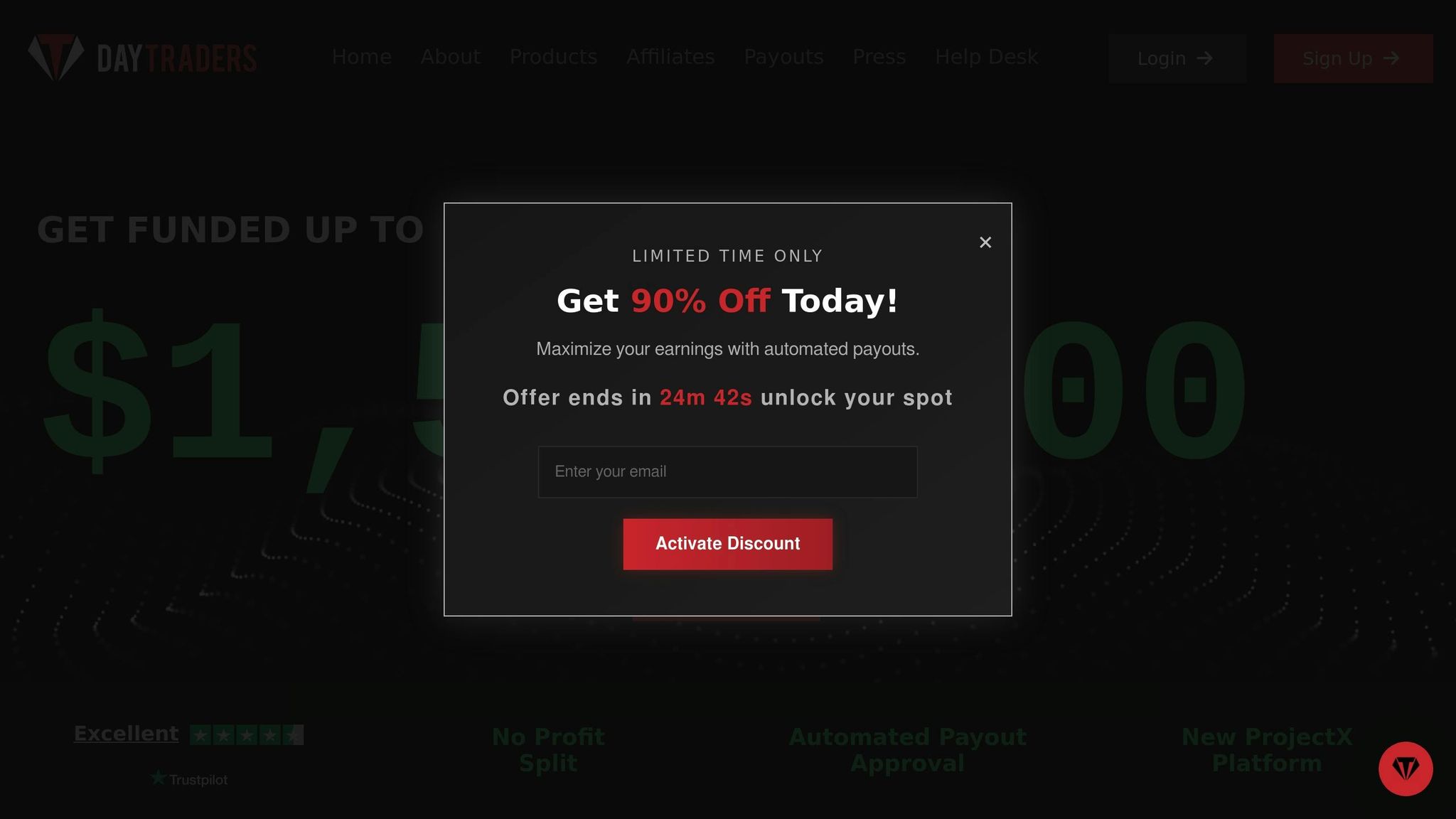
Established in 2025, Day Traders is a futures prop trading firm designed to offer swift account growth paired with a sleek, user-friendly dashboard. What sets them apart is their commitment to evolving their platform based on direct input from traders. This approach makes Day Traders a dynamic and appealing choice in today’s competitive trading landscape.
15. BluSky Trading

Established in 2022, BluSky Trading provides straightforward and accessible funding options tailored for intraday traders. The company emphasizes competitive terms designed to be both clear and appealing.
Evaluation Cost
With evaluation plans starting at just $49 per month, BluSky Trading makes it easy for traders to get started without breaking the bank. This affordable entry point is particularly attractive for beginners or those testing the waters with multiple proprietary trading firms. It allows traders to manage their budgets effectively during the evaluation process, avoiding hefty upfront costs.
Profit Split
BluSky Trading offers a profit-sharing arrangement that ranges from 80% to 90% in the trader’s favor. These terms are on par with the best in the industry, allowing traders to retain a significant portion of their earnings. The exact split may depend on factors like account type or individual performance, but the focus remains on rewarding traders for their success.
Payout Speed
The firm ensures traders have quick access to their earnings by processing payouts promptly. This efficient system eliminates unnecessary waiting periods, enabling traders to reinvest or use their profits without delay. It’s a practical approach that aligns with the needs of active traders.
Ease of Scaling
BluSky Trading simplifies the process of scaling accounts by increasing capital as traders demonstrate consistent profitability. Their scaling model avoids complicated requirements, allowing traders to focus on their performance rather than navigating complex milestones. This straightforward approach makes growing an account more accessible for traders at all levels.
16. Phidias Propfirm
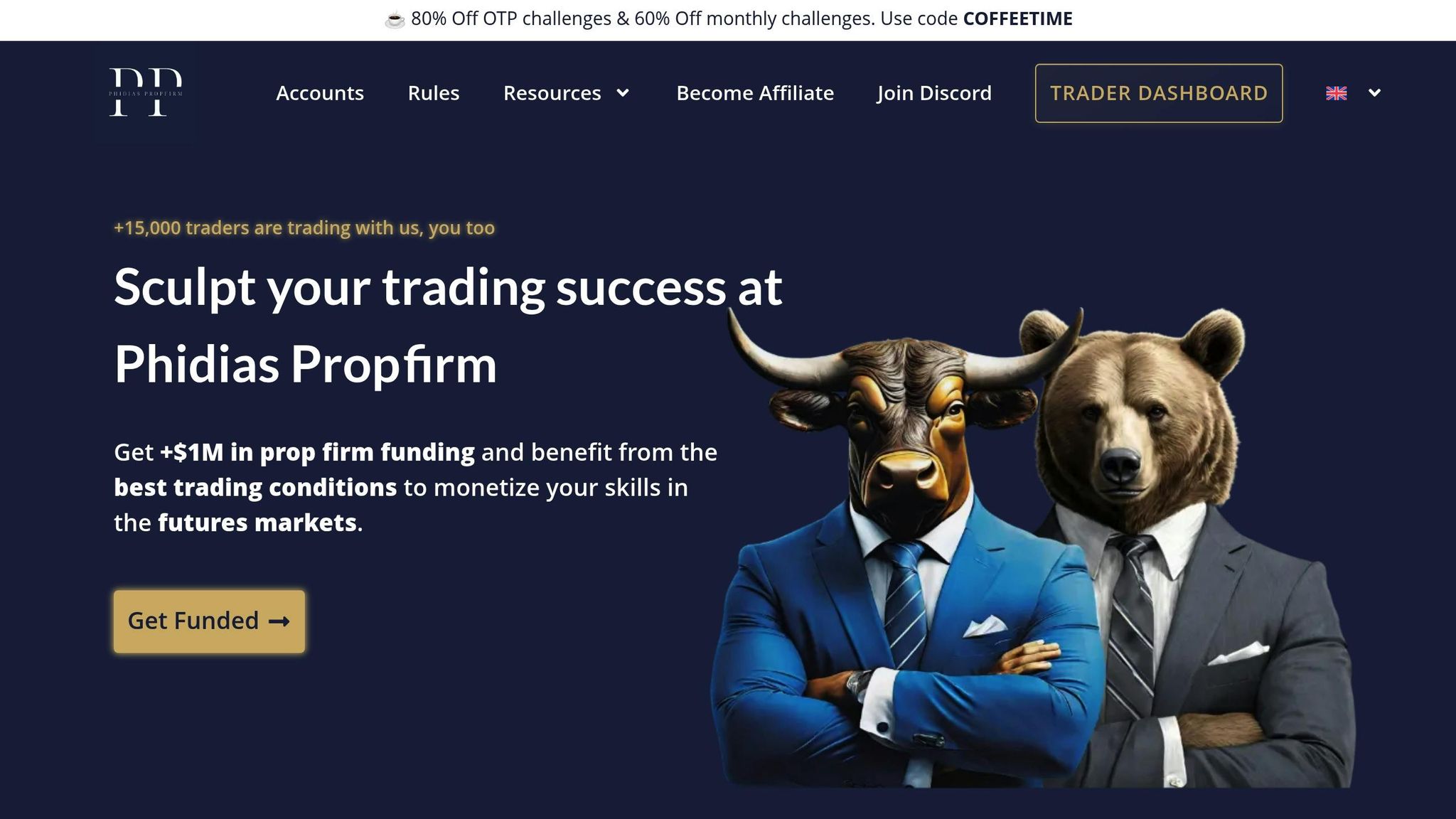
Launched in 2024 and headquartered in Gibraltar, Phidias Propfirm approaches futures prop trading with a modular system that stands out from the more traditional setups. The firm emphasizes transparent performance tracking and offers customizable programs tailored to different trading styles and experience levels. Let’s take a closer look at what they bring to the table.
Evaluation Cost
Phidias Propfirm provides flexible evaluation packages designed to grow with a trader’s performance. Instead of sticking to a single evaluation fee, they offer multiple entry points, allowing traders to start small and increase their commitment as they prove their skills. This modular design helps traders manage their expenses while offering clear opportunities for advancement.
Profit Split
The firm features flexible and performance-based profit-sharing options. Their system ensures traders can track exactly how their profit splits are calculated and when they qualify for better terms. Profit-sharing levels vary depending on the program a trader chooses, and all details are accessible through their performance dashboard. This structure ensures traders are rewarded fairly and transparently for their consistent results.
Payout Speed
Fast withdrawals are a key focus at Phidias Propfirm. Their streamlined processes make sure traders can access their profits quickly and without unnecessary delays. The tracking system provides real-time updates, so traders always know the status of their withdrawal requests. This efficient infrastructure ensures payouts are timely and dependable, which is a crucial feature for traders relying on steady access to their earnings.
Ease of Scaling
Scaling with Phidias Propfirm is designed to be straightforward and stress-free. Their modular program structure eliminates complicated milestones, replacing them with clear and consistent performance metrics. Traders can see exactly what they need to achieve to grow their accounts, and they can progress at their own pace.
This progressive scaling model caters to different trading strategies and timelines, allowing traders to build their accounts sustainably without feeling pressured to meet arbitrary deadlines. It’s a system that prioritizes flexibility and long-term growth, making it appealing to traders at all levels of experience.
17. Purdia Capital
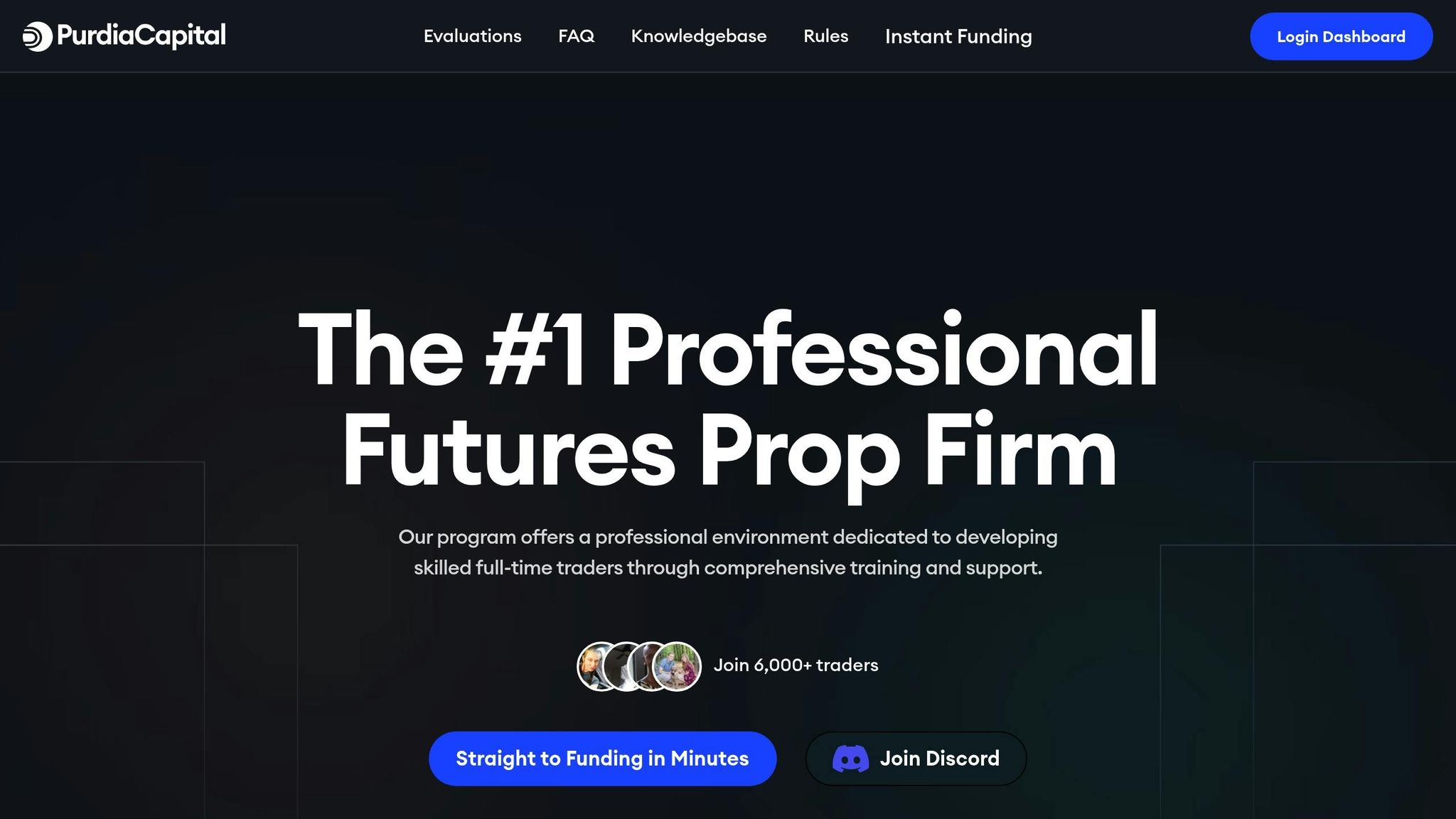
Purdia Capital has made a name for itself with its lightning-fast payout processing. Once traders reach Live Funded Account status and start generating profits, they can expect their payout requests to be handled in just 24 hours.
Payout Speed
Traders with Live Funded status have the option to request payouts daily.
"Payments will be processed within 24 hours of being received." – Purdia Capital
This speed and efficiency have been praised by traders:
"The payout process is incredibly smooth – I received my first payout within a day of requesting it!" – Daniel Masterson
18. Legends Trading
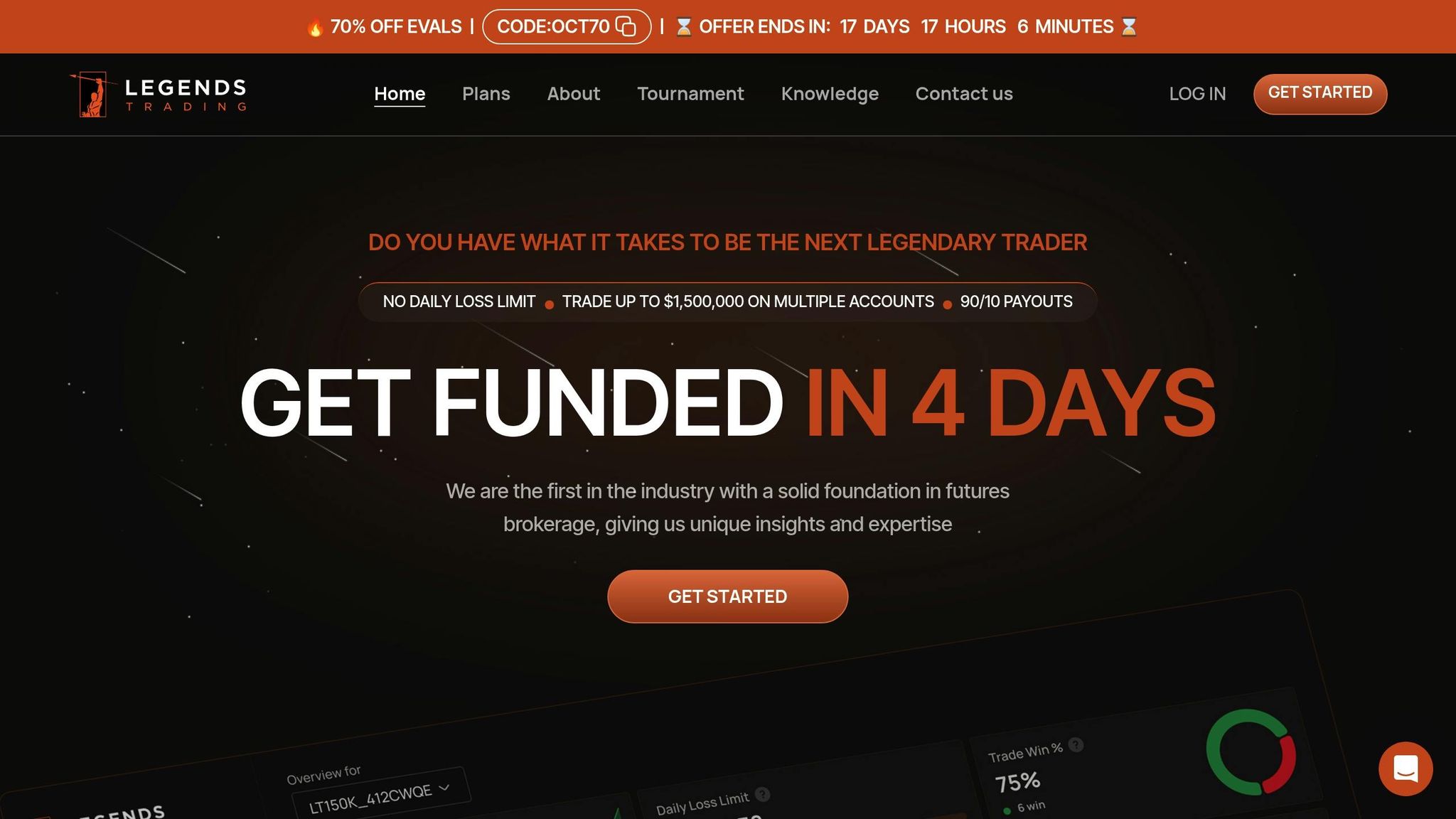
Launched in 2024, Legends Trading quickly gained attention for its modular evaluation process and clear performance tracking. In its first year, the platform reported over 2,500 active funded traders and average monthly payouts surpassing $1.2 million. Its structure is designed to offer straightforward evaluations, attractive profit-sharing options, and smooth account growth.
Evaluation Cost
Legends Trading provides tiered pricing options, starting at $99 for a $25,000 account. For larger accounts, ranging up to $150,000, fees vary between $299 and $499. After passing the evaluation, traders pay a one-time challenge fee, with no additional monthly costs. The firm maintains an 18% evaluation pass rate.
Profit Split
Traders on standard accounts receive an 80% profit split, while those on premium accounts enjoy a higher 90% split after completing the evaluation process.
Payout Speed
Payouts are processed weekly, with requests submitted before 2:00 PM ET receiving same-day processing. This quick turnaround ensures traders have timely access to their earnings, which is critical for maintaining active trading strategies.
Ease of Scaling
Legends Trading offers milestone-based scaling, allowing traders to double their account size upon meeting specific goals. For instance, accounts can double once traders achieve a 10% profit and demonstrate consistent risk management over 30 consecutive days. This structured scaling approach supports traders aiming to grow their accounts efficiently.
19. Apex Trader Funding (Program Variants)
Apex Trader Funding goes beyond its standard offerings by introducing alternative program variants that cater to a wide range of trading styles and experience levels. These programs are designed with flexibility in mind, offering traders adjusted evaluation processes, customized profit-sharing arrangements, structured payout schedules, and faster paths to account scaling.
Evaluation Cost
The cost for these programs operates on a flexible fee model. For the most up-to-date information, refer to Apex Trader Funding‘s official guidelines.
Profit Split
Profit-sharing percentages vary depending on the specific program, rewarding traders who consistently perform well. Details on these splits can be found in the program’s documentation.
Payout Speed
These programs prioritize timely payouts, with enhanced options available after reaching certain milestones. Be sure to review the official materials for the latest payout details.
Scaling Opportunities
Traders can take advantage of accelerated account scaling as they hit performance benchmarks. Specific scaling increments and requirements are outlined in the firm’s official guidelines.
20. TradeDay (Alternate Plans)
TradeDay continues to prioritize trader support with its alternate plans, offering more options to fit different trading approaches. These plans tweak the evaluation process and funding paths while staying true to TradeDay’s focus on coaching and trader development. By adjusting factors like evaluation costs, profit splits, and scaling opportunities, these plans cater to a variety of trading preferences.
The alternate plans are ideal for traders who need more flexible timelines or customized risk settings compared to TradeDay’s standard options. This adaptability allows TradeDay to welcome a wider range of trading styles while maintaining its dedication to education and skill-building.
Evaluation Cost
Flexibility is key here. The alternate plans come with pricing that aligns with their adjusted evaluation parameters. For the most accurate and up-to-date pricing, refer to the program’s official documentation.
Payout Speed
Reliability remains a cornerstone of TradeDay’s operations. The alternate plans ensure dependable payouts, though the timelines may differ based on the specific plan and trader performance.
Profit Split
To reward consistent performance and sound risk management, the alternate plans feature tiered profit splits. These splits are designed to incentivize traders who demonstrate sustained profitability. Details on the specific splits can be found in each plan’s terms.
Ease of Scaling
In line with TradeDay’s emphasis on growth and education, the alternate plans include structured scaling options. As traders hit clear performance targets, their account sizes increase, providing a pathway for steady and sustainable growth. This approach aligns seamlessly with TradeDay’s coaching philosophy, ensuring traders are supported every step of the way.
Comparison Table
Take a closer look at the table below to compare each firm’s year of establishment, headquarters, and standout features. This will help you determine which program aligns best with your trading preferences and goals.
| Firm Name | Year Established | Headquarters | Key Features |
|---|---|---|---|
| FundingTicks | 2025 | AE | Emerging leader offering low-cost evaluations, quick approvals, and same-day payouts. |
| FundedNext Futures | 2025 | AE | Strong global presence; ideal for traders transitioning from FX to futures. |
| Tradeify | 2024 | US | Offers instant funding and seamless platform integrations. |
| My Funded Futures | 2023 | US | Known for simple rules, a solid US reputation, and dependable payouts. |
| Take Profit Trader | 2021 | US | A steady mid-tier option focused on gradual scaling. |
| Topstep | 2012 | US | Industry veteran with extensive educational resources and long-term reliability. |
| Lucid Trading | 2025 | US | Features a user-friendly interface, clear rules, and fast withdrawal processes. |
| TradeDay | 2020 | US | Well-established with strong coaching and trader support. |
| Apex Trader Funding | 2021 | US | Boasts a large community, frequent discounts, and flexible account options. |
| The Futures Desk (UK) | 2024 | UK | Offers strong support in the EU/UK region with clear rules and professional guidance. |
| The Futures Desk (US) | 2024 | US | US-based counterpart with similar rules and localized services. |
| TickTick Trader | 2022 | IM | Focuses on competitive pricing and straightforward evaluations. |
| Bulenox | 2021 | US | A favorite among discount seekers with simple payout milestones. |
| Day Traders | 2025 | US | New entrant prioritizing fast scaling and modern dashboard features. |
| BluSky Trading | 2022 | US | Provides balanced fees and payouts, suitable for consistent intraday traders. |
| Phidias Propfirm | 2024 | GI | Offers modular programs with transparent performance tracking. |
| Purdia Capital | 2024 | US | A fresh US option with competitive fees and easy-to-understand rules. |
| Legends Trading | 2024 | US | Focused on growth-oriented programs and fostering an active trading community. |
| Apex Trader Funding (Program Variants) | 2021 | US | Highlighted again for its diverse program options and promotional deals. |
| TradeDay (Alternate Plans) | 2020 | US | Listed separately to reflect alternative plans and promotions available this year. |
Use the details provided to find the firm that best suits your trading approach.
Conclusion
Selecting a prop firm that aligns with your trading approach and financial goals is key to your success. The reviews above shed light on how elements like transparency, payout efficiency, and reliable infrastructure can make a significant difference for traders.
Transparency should always be a top consideration. Clear rules and fee structures protect your interests and ensure fair treatment. Firms that offer real-time performance tracking and detailed rulebooks show they value fairness and accountability, which pairs well with efficient evaluation processes.
Payout speeds are another critical factor. Quick payouts can stabilize your cash flow, while delays might hinder your financial planning. For instance, Apex Trader Funding allows traders to keep up to 100% of the first $25,000 in profits with weekly distributions, whereas some firms may take weeks to process withdrawals. Faster payouts can have a direct impact on your financial stability.
A stable trading platform is essential for consistent performance. Seamless integration with tools like NinjaTrader and TradeStation can make a world of difference. A firm with a solid technical foundation can provide the reliability you need to focus on your strategy without unnecessary disruptions.
Additionally, factors like profit splits, account sizes, and payout terms vary significantly between firms, directly influencing your earnings and flexibility. These details should align with your trading style and goals.
For technical support, having a dependable infrastructure is just as important. Services like QuantVPS offer high-performance VPS hosting with ultra-low latency and 100% uptime – ensuring your trading system runs smoothly alongside your prop firm partnership.
Before committing, take the time to compare evaluation criteria, community feedback, and each firm’s track record. The right choice will not only provide the capital you need but also the tools and support to help you grow and succeed in your trading career.
FAQs
What should I look for when selecting a futures prop trading firm from the list?
When you’re picking a futures prop trading firm, it’s crucial to weigh factors like profit splits, evaluation processes, fees, and account options. Every firm has its own set of perks, so finding one that aligns with your trading objectives is key.
Some firms might offer better profit splits or lower fees, while others focus on speedy payouts or solid educational tools. If you’re just starting out, prioritize firms with simple rules and robust support. On the other hand, seasoned traders might value firms offering flexible account sizes and quick scaling opportunities.
The goal is to choose a firm that fits your trading style, financial plan, and long-term aspirations, setting you up for success in futures trading.
How do profit splits and payout speeds differ among the top futures prop trading firms?
Profit splits and payout speeds can vary widely across futures prop trading firms, giving traders plenty of options to find what works best for them. Apex Trader Funding stands out by offering traders 100% of the first $25,000 in profits, followed by a 90% split on anything beyond that. Payouts are processed every eight trading days, ensuring a steady rhythm for withdrawals.
On the other hand, My Funded Futures provides 100% of the first $10,000 in profits and then moves to a 90% split. What sets them apart is their flexible payout system, designed to cater to individual trader preferences.
For those seeking quicker access to their earnings, Take Profit Trader allows profit splits between 80% and 90%, with the added perk of immediate withdrawals. Similarly, FXIFY offers up to a 90% profit split but processes payouts bi-weekly, ensuring consistent access to funds.
These differences give traders the freedom to select a firm that matches their financial priorities and preferred payout schedules.
Which futures prop trading firms are better for beginner traders versus experienced traders?
For those just starting out, Apex Trader Funding and My Funded Futures are solid choices. They stand out for their straightforward evaluation processes and flexible rules, making it less intimidating for beginners to dive in. Apex Trader Funding sweetens the deal with frequent discounts and a variety of account options, while My Funded Futures keeps things simple with a single-step evaluation process.
More seasoned traders may gravitate toward options like FundedNext Futures or FXIFY. FundedNext Futures is particularly appealing for traders transitioning from forex to futures markets. On the other hand, FXIFY offers access to up to $400,000 in capital and provides instant payouts, catering to advanced strategies and the needs of experienced professionals.








